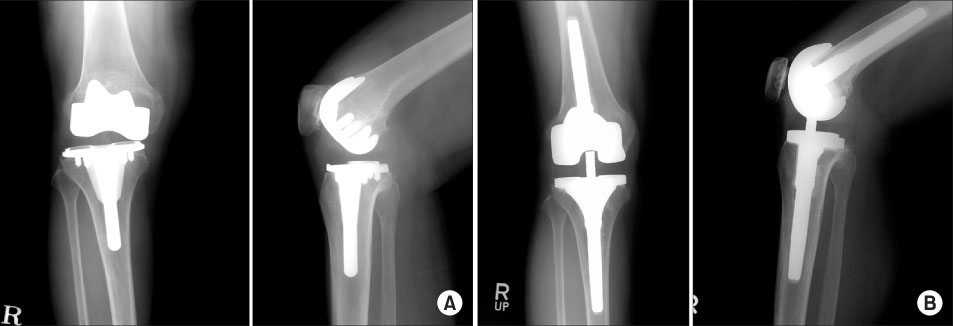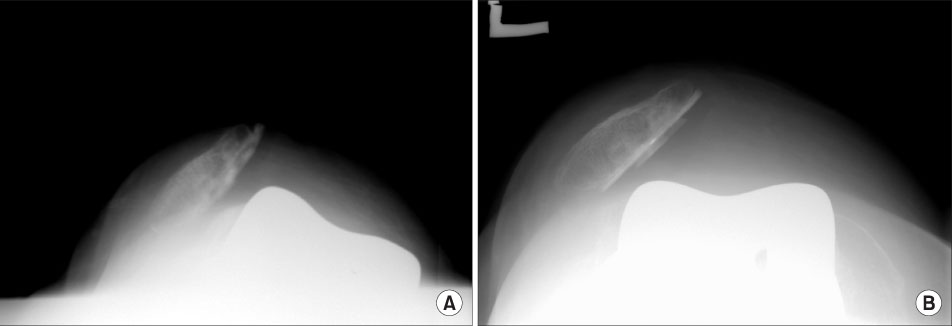J Korean Orthop Assoc.
2007 Oct;42(5):578-585. 10.4055/jkoa.2007.42.5.578.
The Methods and Results of Revision Total Knee Arthroplasty
- Affiliations
-
- 1Department of Orthopedic Surgery, Asan Medical Center, College of Medicine, Ulsan University, Korea. wscho@amc.seoul.kr
- 2Department of Orthopedic Surgery, Seoul,Ulsan University Hospital, Ulsan, Korea.
- 3Department of Orthopedic Surgery, Kangnam Sacred Heart Hospital, College of Medicine,Hallym University, Seoul, Korea.
- KMID: 2186463
- DOI: http://doi.org/10.4055/jkoa.2007.42.5.578
Abstract
-
PURPOSE: To suggest operative methods for revision total knee arthroplasty (TKA) according to the causes of revision surgery.
MATERIALS AND METHODS
The operative methods of 70 revision total knee arthroplasties in 64 patients between December 1996 and December 2004 were analyzed according to the causes. The mean follow-up period was 65 months (25-120 months). The range of motion and Hospital for Special Surgery (HSS) score were used for the clinical evaluation and the scoring system of American Knee Society was used for the radiographic evaluation.
RESULTS
The mean periods of revision surgery from the initial operation was 59 months (1 month-20 years). Posterior cruciate retaining prosthesis was used in 8 cases, posterior cruciate substituting prosthesis in 14 cases, and constrained type prosthesis in 48 cases. The extension stem was required in 51 cases, metal augmentation in 34 cases, and structural allograft in 15 cases for bone defect treatment and firm fixation. The average range of motion improved from 88.8o preoperatively to 105.8o at the final follow-up. HSS score also improved from 60.5 to 87.6 points. The complications after revision TKA were 3 infections (4.3%), 1 patellar dislocation (1.4%), and 1 polyethylene dislocation (1.4%).
CONCLUSION
Constrained type prostheses were needed in many cases of revision TKA. Satisfactory results were obtained using an additional structural allograft, metal augmentation, and extension stem for bone defect treatment and firm fixation.
Keyword
MeSH Terms
Figure
Cited by 1 articles
-
Results of Two Stage Revision of Infected Total Knee Arthroplasty (A Minimum 5-year Follow-up Analysis)
Woo-Shin Cho, Jeong-Ho Kang, Sang-Jun Lee, Sung-Hoon Ha
J Korean Orthop Assoc. 2011;46(3):244-249. doi: 10.4055/jkoa.2011.46.3.244.
Reference
-
1. Ahlberg A, Lunden A. Secondary operations after knee joint replacement. Clin Orthop Relat Res. 1981. 156:170–174.
Article2. Bert JM. Dislocation/subluxation of meniscal bearing elements after New Jersey low-contact stress total knee arthroplasty. Clin Orthop Relat Res. 1990. 254:211–215.
Article3. Brick GW, Scott RD. The patellofemoral component of total knee arthroplasty. Clin Orthop Relat Res. 1988. 231:163–178.
Article4. Buechel FF, Pappas MJ. Long-term survivorship analysis of cruciate-sparing versus cruciate-sacrificing knee prostheses using meniscal bearings. Clin Orthop Relat Res. 1990. 260:162–169.
Article5. Cameron HU, Hunter GA, Welsh RP, Bailey WH. Revision of total knee replacement. Can J Surg. 1981. 24:418–420.6. Chin KR, Bae DS, Lonner JH, Scott RD. Revision surgery for patellar dislocation after primary total knee arthroplasty. J Arthroplasty. 2004. 19:956–961.
Article7. Elia EA, Lotke PA. Results of revision total knee arthroplasty associated with significant bone loss. Clin Orthop Relat Res. 1991. 271:114–121.
Article8. Friedman RJ, Poss R. Revision total knee arthroplasty in patients with osteoarthritis. Rheum Dis Clin North Am. 1988. 14:537–544.
Article9. Goldberg VM, Figgie MP, Figgie HE 3rd, Sobel M. The results of revision total knee arthroplasty. Clin Orthop Relat Res. 1988. 226:86–92.
Article10. Goldman RT, Scuderi GR, Insall JN. 2-stage reimplantation for infected total knee replacement. Clin Orthop Relat Res. 1996. 331:118–124.
Article11. Gustke KA. Preoperative planning for revision total knee arthroplasty: avoiding chaos. J Arthroplasty. 2005. 20:Suppl 2. 37–40.12. Haas SB, Insall JN, Montgomery W 3rd, Windsor RE. Revision total knee arthroplasty with use of modular components with stems inserted without cement. J Bone Joint Surg Am. 1995. 77:1700–1707.
Article13. Hanssen AD, Rand JA, Osmon DR. Treatment of the infected total knee arthoplasty with insertion of another prosthesis: the effect of antibiotic-impregnated bone cement. Clin Orthop Relat Res. 1994. 309:44–55.14. Hofmann AA, Kane KR, Tkach TK, Plaster RL, Camargo MP. Treatment of infected total knee arthroplasty using an articulating spacer. Clin Orthop Relat Res. 1995. 321:45–54.
Article15. Insall JN. Revision of total knee replacement. Instr Course Lect. 1986. 35:290–296.16. Rand JA, Bryan RS. Revision after total knee arthroplasty. Orthop Clin North Am. 1982. 13:201–212.
Article17. Ritter MA, Eizember LE, Fechtman RW, Keating EM, Faris PM. Revision total knee arthroplasty. A survival analysis. J Arthroplasty. 1991. 6:351–356.18. Vince KG, Long W. Revision knee arthroplasty. The limits of press fit medullary fixation. Clin Orthop Relat Res. 1995. 317:172–177.19. Vince KG. Revision knee arthroplasty technique. Instr Course Lect. 1993. 42:325–339.20. Windsor RE, Insall JN, Urs WK, Miller DV, Brause BD. Two-stage reimplantation for the salvage of total knee arthroplasty complicated by infection: further follow-up and refinement of indications. J Bone Joint Surg Am. 1990. 72:272–278.
Article
- Full Text Links
- Actions
-
Cited
- CITED
-
- Close
- Share
- Similar articles
-
- Assessment of Failure Modes in Total Knee Replacement Arthroplasty
- Causes and Clinical Outcomes Associated with Re-revision Total Knee Arthroplasty
- Management of Cyst on Anterior Tibia following Cementless Total Knee Arthroplasty: Case Report
- Revision Total Knee Arthroplasty Using the PFC Sigma Knee System
- A Case of Candida Glabrata Infection after Total Knee Arthroplasty



